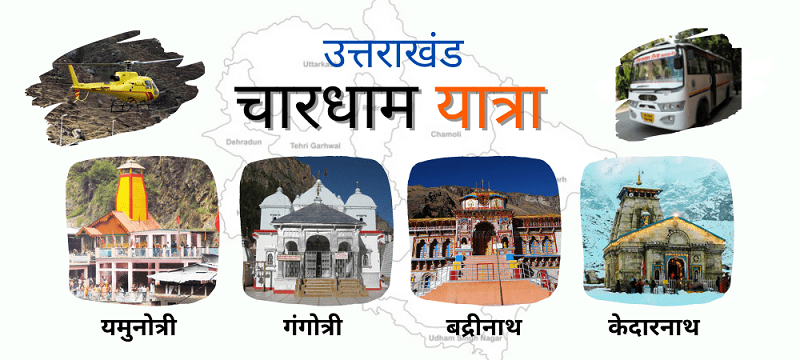The Char Dham Yatra
The Char Dham Yatra Uttarakhand is four pilgrimage destinations of Yamunotri, Gangotri, Kedarnath, and Badrinath, collectively known as Char Dham, which are snuggled among the majestic peaks of the mighty Himalayas. These sacred sites attract the most pilgrims each year, making them the premier religious travel hubs in the Northern parts of India.
The Char Dham Yatra in Uttarakhand is a spiritual and inner-self-improvement pilgrimage. The goal of this sacred pilgrimage is to achieve liberation, or moksha, which is Hinduism’s ultimate state of emancipation.
The four temples are devoted to distinct gods and goddesses and are located in four different directions across Uttarakhand. The Char Dham Yatra is a religious pilgrimage to the ancient Shrines of Badrinath (Lord Vishnu’s dwelling), Kedarnath (Lord Shiva’s home), Gangotri (Goddess Ganga’s abode), and Yamunotri (Goddess Yamuna’s habitation).
The pilgrimage typically begins in the west and ends in the east. As a result, the Char Dham Yatra places begins in Yamunotri and continues to Gangotri, Kedarnath, and then to Badrinath.
It’s a quest to get away from the world’s allure and into the Almighty’s Eden-like sanctuary, where the world’s tumult ceases and ethereal peace reigns supreme.
Devotees from all over the world travel to Uttarakhand to visit these temples since they are so important in the Hindu religion. The Gangotri and Yamunotri Dhams are also the birthplaces of India’s two most respected, holy, and sacred rivers, the Ganga and the Yamuna, respectively. The first Dham, Kedarnath, is dedicated to Lord Shiva and is one of Shiva’s 12 Jyotirlinga, while the last Dham, Badrinath, is dedicated to Lord Vishnu.
Yamnotri
Yamunotri is the first Dham, or shrine, on Uttarakhand’s Chota Char Dham tour. Yamunotri Dham is home to the Yamuna Devi temple and is also the source of the Yamuna River, one of Hinduism’s sacred rivers.
The actual source of the Yamuna River is the Champasar Glacier, which is located on the Kalind Mountain’s foothills. The goddess Yamuna’s main temple is located at a height of 3,291 metres above sea level and is accessible by a 6-kilometer journey from Jankichatti.
The temple was built on the left bank of the Yamuna River by ‘Maharaja Pratap Shah,’ the king of Uttarakhand’s Tehri dynasty. The temple’s Idol is made of black marble and has a stunning appearance.
Yamunotri Temple Highlights
- Location: Uttarkashi, Uttarakhand
- Gates Open: Late April to Early May (Akshaya Tritiya)
- Gates Closes: Late October or Early November ( Yama Dwitiya)
- Nearest Railway Station: Dehradun
- Nearest Airport: Jolly Grant, Dehradun
- Total Trekking: 6 kms from Janki Chatti
- Total Distance from Delhi: 419 Km
Gangotri
Gangotri is the second in the Chota Char Dham group, and like Yamunotri, it is located in Uttarakhand’s Uttarkashi district at an incredible elevation of 3,100 metres. This little helmet is situated on the bank of the heavenly Bhagirathi river, which was renamed Ganga following its confluence with the Alaknanda river at Devprayag. Amar Singh Thapa, a Nepalese ruler, was the first to build the Ganga shrine at Gangotri. Gaumukh in Gangotri glacier is the Ganga’s original source.
On the right bank of the Bhagirathi River stands the breathtaking Gangotri temple. The temple is composed of white marble and surrounds the Ganga River. The idol resembles that of other Hindu goddesses.
Gangotri temple highlights
- Location: Uttarkashi, Uttarakhand
- Gates Open: Late April to Early May (Akshaya Tritiya)
- Gates Closes: Late October or Early November ( Yama Dwitiya)
- Winter Seat: Mukhba Village
- Nearest Railway Station: Dehradun
- Nearest Airport: Jolly Grant, Dehradun
- Trekking Distance: Negligible
- Distance from Delhi: 487 km
Kedarnath
Kedarnath is the third temple in the Char Dham route and Lord Shiva’s ultimate and most revered temple. Kedarnath is also one of Hindu god Shiva’s 12 holy Jyotirlinga. It is not simple to get to this temple, as it requires an 18-kilometer hike from Gaurikund. Helicopter services are also available, however, they are not cheap or environmentally friendly, as the Himalayas is a delicate area.
It’s 3,553 metres above sea level, with snow-capped Himalayan peaks in the vicinity. The temperature in Kedarnath stays severely cold even in May and June. Following the 2013 flood, the infrastructure of the Kedarnath shrine is virtually complete, and housing and basic services are now available.
The Pandavas came to seek Lord Shiva’s blessings to absolve themselves of the guilt of killing their relatives, the Kauravas, during the Mahabharata period. Realizing this, Lord Shiva transformed himself as a humped buffalo and hid in Kashi, which was later renamed Guptkashi.
The Pandavas soon found Lord Shiva, who was hiding deep in the ground with his hump bulging; Lord Shiva then appeared before them, impressed by the Pandavas’ perseverance.
Kedarnath Temple Highlights
- Location: Rudraprayag, Uttarakhand
- Gates Opens on: The first week of May
- Gates Closes on: Late October to November
- Winter Seat: Ukhimath
- Nearest Railway Station: Rishikesh
- Nearest Airport: Jolly Grant, Dehradun
- Total Trekking: Around 18 Kms
- Total Distance from New Delhi: 480 km
Badrinath
Badrinath is Uttarakhand’s unique shrine that is a part of both the Chota Char Dham and the Char Dham of India. The Badrinath temple is the final and fourth temple on this pilgrimage route, earning it the moniker ‘Moksha Dham’. Highway roads connect Badrinath to the rest of the world. If you plan on visiting this shrine, be sure to dress warmly because it is located at an astounding elevation of 3,300 metres. The Badrinath temple is dedicated to Vishnu, Hinduism’s ultimate god.
The temple is built in classical garhwali style and is located on the right bank of the Alaknanda River, beneath the majestic Neelkanth hill. Inside Badrinath temple, a black stone figure of Lord Badrinarayan constructed of Saligram stone unearthed by Shankaracharya in the Alaknanda river is a wonderful sight.
Badrinath Temple gets its name from the native word Badri, which refers to a variety of wild berries. According to mythology, when Lord Vishnu was performing penance in the Himalayas, his consort Goddess Laxmi appeared in the shape of a berry tree and shielded Lord Vishnu from the blazing sun.
Along with being the abode of Lord Vishnu, Badrinath is home to many saints, pilgrims, and sages who meditate here in search of enlightenment.
Badrinath Temple Highlights
- Location: Chamoli, Uttarakhand
- Gates open on the First week or second week of May
- Gates close on Middle of November
- Winter Seat: Joshimath
- Nearest Railway Station: Rishikesh
- Nearest Airport: Jolly Grant, Dehradun
- Total Trekking Distance: 300 metres only
- Distance from Delhi: 542 km
Opening and Closing Months of Chota Char Dham in Uttarakhand
All four pilgrimage sites are located in the Garhwal Himalayas, which get heavy snowfall every winter, making entry difficult for the average tourist. Because of the inaccessibility, these places have a particular practice of closing the temples for six months during the winter.
Temple deities are relocated to their winter abode in Uttarakhand around this time. On the celebration of Akshay Tritya, the Char Dham temples in Uttarakhand open in April.
Devotees are drawn to this pilgrimage journey by a cyclone of enthusiasm and spirituality, but what makes it even more fascinating are the breathtaking vistas of the Himalayas, meadows, mountain forests, waterfalls, valleys, rivers, and other beautiful faces of nature that one comes across along the way.
The trek leads you to Gaurikund, Adi Shankaracharya Samadhi, Tapt Kund, Brahma Kapal, Kedarnath Gufa, Neelkanth Peaks, Vasuki Taal, Bhagirathi River, Surya Kund, Divya Shila, and many more important locations.




